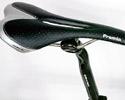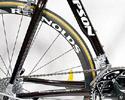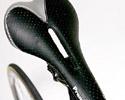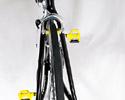
Recently on Cyclingnews.com |
On test: Sampson Diablo 20, October 29, 2007
Sampson on song
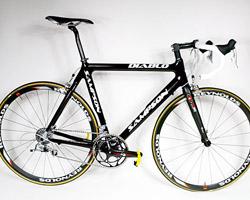
|
Eric Sampson has been creating components and waves in the bicycle industry for more than two decades and celebrates the milestone with a 20th anniversary edition of his carbon Diablo frame. Cyclingnews' Mark Zalewski puts the bike to an all-around test with a summer of fun riding and fast racing.
Straight out of the box, the Sampson Diablo looks like a fairly typical bare clearcoated carbon fiber frame - ho hum. But looking closer, especially in the sunlight, the Diablo offered the first of many surprises and illustrates that the devil really is in the details. The bare carbon is really coated with a tinted clear coat of red, giving it a distinct and unique look that changes with the light. If subtlety is your game, then the Diablo might just be your bike.
A frame, and more
The Diablo is a result of Sampson's years of experience in the industry, and according to him, his years of actually listening to the people who ride his products. One of the top complaints must have been that high performance frames (including carbon ones) ride too uncomfortably and transfer too much road vibration up to the rider. In Sampson's eyes, companies have continued to push the limits in areas such as stiffness and lightness, which rate well on the lab bench and seem good on shorter rides, but not enough attention has been paid to ride quality.
Enter the Sampson Attenuation System (SAS), a frame treatment that is claimed to reduce frame vibration and noise for a much more comfortable ride without adding too much extra mass or sacrificing overall performance. Sampson suggests that the improved ride will leave you fresher as the finish line approaches, and with less frame noise, you will also be better equipped to launch that sneak attack on the peloton without anyone hearing you…
So what is SAS, you ask? Is it just another version of (insert any number of recent buzzwords here)? Sampson says that the answer is not the tube itself, but what is inside the tube. No, not unicorns and leprechauns... polymers! In the adapted words of one Irwin Fletcher, "It's all polymers nowadays!"
More specifically, variable durometers of foam polymers are injected under pressure in strategic areas of the frame to act as a damper. Durometer is a technical way of measuring hardness, and by including a relatively broad range of polymers, different frequencies of vibration can be damped more effectively, or so the theory goes. Sampson says that while other technologies legitimately address vibration issues, SAS is more comprehensive as it treats the tubes that are the biggest contributors instead of just the small offenders. In addition, the small amount of polymer only adds a marginal amount of weight, and the rest of the carbon structure can be solely dedicating towards maintaining drivetrain and torsional rigidity.
Sampson also offers a variety of components and drivetrain options, and our 56cm tester was definitely so-equipped as the handlebars, stem, seat, seatpost, cranks, bottom bracket, chainrings, brakes, and pedals were all from Sampson's Stratics line of components (save for the Premia saddle). The remainder of the drivetrain (cassette, chain, levers) was borrowed from SRAM's Rival group, while rolling duties were handled by Reynolds Cycling's economically priced Attack carbon wheels and premium Veloflex open tubular tires. Claimed weight for the bare frame is about 1150g (the new Diablo S sits right around the 1kg mark), and the total weight, as tested, was a reasonable 7.6kg (16.8lb) including pedals.
Hitting the road
Putting the Diablo on the road was a pleasure right from the start. The much-touted SAS concept is touted for a reason - the ride is indeed comfy. The northern Midwestern test grounds used here were a mix of tarmac quality, to say the least - from the occasional glassy smooth road from recent repairs to the more usual cracked and chip-sealed routes, as well as some downright Roubaix-like sections that are tolerated only to reach better roads on the way out of town.
The SAS effectively dulled the constant annoying small vibrations that you never seem to get used to - those obnoxious ones that you do not necessarily consciously notice over a ride but make your upper body fatigued from the shock absorption duties. Even better, the Diablo handled the bigger bumps (as close as we get to mountains out here) with just as much ease.
Even with so much vibration damping, though, the Diablo doesn't seem to make any sacrifices in terms of frame rigidity. Lateral flex was not a problem and overall power transfer was good. There was, however, a little less snappiness in the frame when really putting in digs for those hotly contested sign sprints on the group ride as compared to some other full carbon fiber frames, but not to the point of being a full negative attribute.
Some of the softness may also have been attributed to the choice of wheels. These carbon hoops make for a great set of all-around road race wheels - or if you have deeper pockets, a set of fancy training wheels - but something a little more rigid would be preferred for sprint-heavy race situations such as crits. Swapping them out for a set of stiffer Zipp 404s, or a set of aluminum hoops on a few crit racing occasions, enhanced the overall race-ability of the frame.
Going uphill with the Diablo presented a nice constant return on my pedal strokes, and heading down the other side demonstrated the Diablo's nice handling responses, even when needing to make quick decisions and line changes. Other handling situations, such as high-speed cornering, were also nice and smooth - again likely due to the absorption qualities of SAS, which also seemed to enhance overall traction somewhat.
In the case of the Stratics components, if it can be made with carbon, it probably is. We didn't have any issues with any of the components, except for a small aesthetic gripe. The lovely red tint of the frame's clearcoat does clash with the standard nude carbon wrap of the components. However, it is understandable at such an early date for this frame and its finish not to match up with the rest, and it is something that is easily overlooked.
The Stratics handlebars were a particular joy and pleasure. The anatomic shape boasted just mildly flattened tops, allowing for slightly more hand placement variations while still producing the positive aspects behind the flattened design. Other components that did better than expected included the pedals and saddle. The S3 Ti pedals feature ample adjustments to float and position as well as a 6/4 titanium spindle and magnesium body. Weighing only 116g a piece and costing only US$199, the pedals are a good mix of features and lightness for the money. Likewise, the Premia Sensor LX saddle offers hollow titanium rails, a carbon composite base, and real leather for only US$119, yet was comfortable in every ride situation, thanks in part to its pressure-relieving cut-out.
As noted above, the weight of this particular review bike comes in at the middle of the range for racing bikes, but lighter build options are readily available, both from Sampson directly and other vendors, and one could easily bring the overall weight down well before UCI limits just on component choice alone. Luckily, what this particular bike lacked in light weight gadgetry was more than made up in its excellent ride quality, and the fact that a little more money could get you both is certainly enticing
If you fancy yourself a true criterium specialist and make your living jumping out of turns to cash in on primes, you may want something a little stiffer in lieu of the remarkable comfort of the Diablo. But for the other 99% of us out there, with the majority of time spent on our bikes training with friends and racing on the weekends, the Diablo is a perfect all-around bike.
Price: US$2699 (frame and fork); US$4418 (complete as tested)
Weight: 7.6kg (16.8 lbs) (as tested)
Pros: Sampson Attenuation System provides silky smooth comfort, nice
line of reasonably priced components
Cons: May lack sufficient rigidity for picky diva sprinters, not the
lightest option out there
Cyclingnews rating: ![]()
Photography
For a thumbnail gallery of these images, click here
Images by Mark Zalewski/Cyclingnews.com
- Sampson's 20th anniversary creation is the Diablo 20, complete with its unique Sampson Attenuation System.
- The Diablo 20 includes a lot of carbon with a splash of yellow.
- The Premia Sensor LX saddle uses hollow titanium rails and a real leather cover.
- The Sampson Stratics carbon seatpost is claimed to weigh just 136g.
- The red tint of the clearcoat gives a unique finish.
- Sampson is one of just a few companies to adhere to the ISIS bottom bracket standard for its Stratics carbon crankset.
- The rear triangle features big carbon sections in the joints.
- The SRAM Rival group delivers identical mechanical function to the pricier Force group with just a slight weight penalty.
- The Premia Sensor LX includes a pressure-relieving cutout.
- The Sampson Stratics stem uses a carbon center section bonded to aluminum ends.
- The angle of envy from your group ride mates.
- Sampson provides plenty of customization in its complete build kits.
- The Sampson Stratics brakes delivered good stopping power.
- The Reynolds Attack wheels include premium all-carbon clincher rims on proven Taiwan-made hubs.
- The Stratics s5 pedals offer nearly all of the performance of their pricier Stratics cousins but at a cheaper price and slighter heavier weight.
- The Veloflex tires combined with the damped ride of the Reynolds Attack carbon clinchers to provide a near-tubular ride quality.
- The Sampson Stratics brakes are claimed to weigh just 270g for the set.
- The bottom bracket area is well reinforced with lots of carbon.
- The flat tops on the Stratics handlebar provided a comfy perch.
- Need more carbon?
- Easton's relatively soft EC90 carbon fork makes for an interesting combination with the Reynolds Attack wheelset.
- Reynolds Cycing's Attack wheels make for a reasonable set of race wheels or an excellent set of training hoops.
- The big carbon tubing suggests a harsh ride, but the Sampson Attenuation System smoothes out the ride impressively.
- Ramped and pinned chainrings delivered smooth shifting.
|
Frame: Sampson Diablo 20, monocoque Toray carbon fiber with alloy
dropouts |
Shift levers: SRAM Rival |

